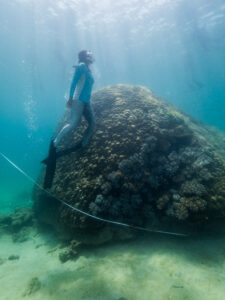 “Using calculations based on rock coral growth rates and annual sea surface temperatures, we think it’s between 421 and 438 years old and predates European exploration and settlement of Australia,” said Dr Smith.
“Using calculations based on rock coral growth rates and annual sea surface temperatures, we think it’s between 421 and 438 years old and predates European exploration and settlement of Australia,” said Dr Smith.
The coral was discovered off the coast of Goolboodi (also known as Orpheus Island), part of the Palm Island Group in Queensland. It has been named Muga dhambi (Big coral) by the Manbarra people, the traditional custodians of the Palm Islands.
“Muga dhambi may have survived up to 80 major cyclones, numerous coral bleaching events and centuries of exposure to invasive species, low tides and human activity. Despite this, it’s in very good health with 70% consisting of live coral,” said Dr Smith.
The coral is described in the journal Scientific Reports this week. Dr Smith said the team of scientists and authors who contributed to the paper ranged from 17 year old Kailash Cook to 76 year old Dr Charlie Veron.
“It’s been an honour to document such a magnificent piece of our Great Barrier Reef. Having a publication with Charlie Veron, the godfather of coral, is a once in a lifetime opportunity that I will never forget.
“Spending time monitoring, exploring and sharing knowledge about the reefs of Goolboodi island with the Reef Ecologic team was an invaluable experience that excites me for a future in the marine science world,” said Dr Smith.
The authors recommend monitoring the rare and unusually resilient large coral and said that with increasing threats from the negative impacts of climate change, declining water quality, overfishing and coastal development, restorative activities may be required to assist the recovery of the Great Barrier Reef, including the protection of corals like Muga dhambi.
Dr Smith said he is proud of the scientific discovery of this coral and the collaboration with traditional owners.
“I recognise that the biggest threat to the Great Barrier Reef is climate change and I am pleased to report that the greenhouse gas emissions of this research were measured and offset as part of our carbon positive policy. Great science is about knowledge and sustainability of the planet.”
‘Field measurements of a massive Porites coral at Goolboodi (Orpheus Island), Great Barrier Reef’, is a scientific paper that is freely available online at: http://nature.com/articles/s41598-021-94818-w.
Contact:
Adam Smith (Townsville)
M: 0418 726 584
Images available here. Please credit Richard Woodgett. Images are for use with media associated with this specific release only. They are not available for re-use, re-sale or archiving.
Timeline
From at least 40,000 BC – now: Indigenous Australians care for land and sea country
20,000-6,000BC Sea level rise
6000BC Age of the Great Barrier Reef
1583- 1600- Porites coral settles on the reef
1770- Captain James Cook and the Endeavour explore the GBR
1887- Orpheus Island was named by Lieutenant G. E. Richards after the Orpheus, a British naval vessel wrecked off the coast of New Zealand in 1863
1974 – Charlie Veron commences coral research at Orpheus Island
1975- Great Barrier Reef Marine Park declared
1978- James Cook University builds Orpheus Island Research Station (OIRS)
1981- Great Barrier Reef declared World Heritage site
2004 OIRS facilities upgraded
2021- Muga dhambi (Big coral) discovered and measured
2021- First scientific paper from OIRS that uses indigenous place name Goolboodi
